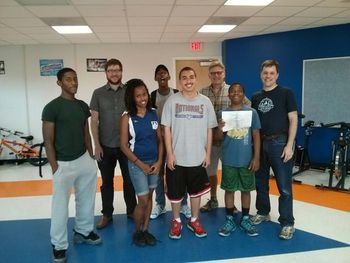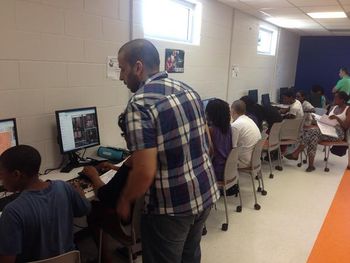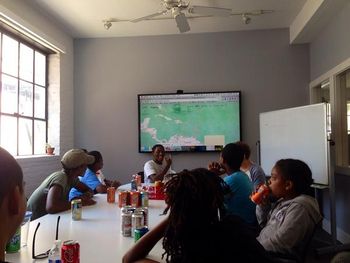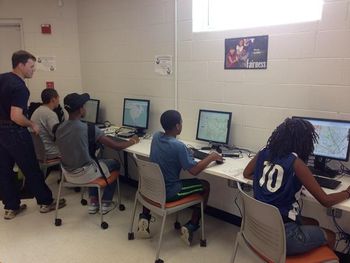Georgia Avenue Youth Ambassadors Mapping Project
In July-August 2014, members of MappingDC worked with about 20 students ages 12-18 in Washington, DC to map out Georgia Avenue, a major commercial corridor in a largely lower-income part of town.
The idea was to collect data on businesses so local groups and citizens can use it, while at the same time teaching the kids new skills and getting them engaged in their community while seeing it from a new viewpoint through geography and mapping. By the end, the students added almost 300 businesses to OpenStreetMap along the street and learned about geography and mapping.
Here's Georgia Avenue now, and the poster-sized map we created with the data!
Project and partners
The project is part of the city's Summer Youth Program, where young people work with local nonprofits on their projects that benefit the community. The nonprofit in this case is MOMIE's TLC, which teaches minority students about local history, social justice, entrepreneurship, business skills and such. Part of their summer curriculum is to work with two local nonprofits, the Georgia Avenue Business Association (GABA) and the Georgia Avenue Community Development Task Force, on a biennial business survey, where they track what businesses exist and what local residents want, then have community meetings to discuss the survey and the mapping data that was collected.
Previously the survey and data was just on the Task Force's website, so it wasn't very easy for people to find or use it -- we figured, why not put this data they're already collecting in a place where it's more accessible and anybody around the world can use, while at the same time getting local kids involved -- OpenStreetMap!
How it happened
The DC Buildings & Addresses Import wasn't finished yet, and buildings for many of the areas around Georgia Avenue were missing. Andrew set up a Humanitarian OSM Team Tasking Manager task, a tool that lets you subdivide an area of interest so multiple volunteers can edit and add what's missing. Volunteers from all over helped add the buildings along the avenue and elsewhere in the area, so we had a good base for the students to use.
After that, Andrew and Steven met with the Youth Ambassadors and organizers and gave a presentation on OpenStreetMap, with a brief demo of the system. They were excited to use it.
Then came the actual business information. The nonprofits developed forms for the students to use, and they went out to collect that data. Having done this multiple times in the past, the nonprofits had good forms and steps worked out already. (Along the way, the students also spoke with business owners about entrepreneurship and business skills, and refined an "elevator speech," as part of their curriculum.) The students also collected some info on the building structures and facades, which the businesses can use to apply for "Great Streets" revitalization grants from the city government.
For the data entry into OSM, Andrew, Steven, Brandon and Richard met with the students at a community center to help them enter the data they collected back into OpenStreetMap. After some compuer struggles (more on that below) we got the students logins and they started to add the data they had collected.
Results
The students mapped at least 268 places, including local businesses, restaurants, fire stations, offices, salons, etc. We expect there are more now the project is done. About 7 students were registered on OpenStreetMap. One student even started mapping mailboxes on the street on her own, outside of the project. We are thinking about more interaction in the future with them, like other community mapping sessions.
The data was also used to create a poster-sized map for a meeting of the Georgia Avenue Community Development Task Force, where local residents will discuss business and development needs. The Youth Ambassadors presented on their project and received a standing ovation, and the maps were printed and used in community conversations during the meeting.
Best Practices/Lessons Learned
- Work with an existing group -- we were lucky to work with an existing group who already had a volunteer base, survey forms, and a good idea for a project. This is a good idea -- don't recreate the wheel or make a new project from scratch, work with an existing group.
- Firefox > Chrome -- The computers we used for inputting the data were at a local community center; they were tiny (maybe no hard drive?) and for some reason Chrome didn't work, it kept crashing every time we hit "save" in iD editor. When we used Firefox it worked just fine.
- Usernames take time -- it took a while for the students to all sign up for usernames. Some forgot their email addresses or their email passwords, so they couldn't register for a username. Maybe there is some other way?
- Multiple "helper" volunteers -- we had 4 adult volunteers who were familiar with OSM to help the ~15 students out as they entered the data into OSM. This was a good number.
- Multiple computers & small groups -- we had about 6 computers and the students were already divided into small groups based on the areas they mapped. We had one student "drive" for a while then had them switch so everybody got familiar with the system. All of this worked well.
- Use Field Papers from the start -- the group didn't use Field Papers from the beginning, so it was sometimes hard to figure out which place was which. Some groups of students had a lot of debating about which building it was, slowing the process down.
- More training on iD -- we basically just had the students dive in, would have been better to do a bit more training on iD editor -- here's what we're adding, here's how to add to an existing place, here's how to search for the correct tag in iD and in the Wiki. We did some of that on the fly when we saw problems were happening like adding a place that already existing, or moving existing places by mistake. We also made sure to check after the saved and validate the edits.
- Computer skills -- some students were not as familiar as using a computer as others. In a bigger project, something more formal on mouse and keyboard skills might be good (this is something HOT often does in their projects.) It was good that the students all got practice though.
- Wifi & projector -- we didn't have either, and that was ok. However, if we were doing more training on OSM, they would be useful.
- Coordination was tricky -- because of the various number of groups involved and volunteers, it was tough to organize and confirm things sometimes. Some people used email, some preferred phone calls. Figuring out what is the best means of communication and having a regular check-in may have helped.
- Phone apps in the future? -- we decided not to use an app like Pushpin OSM because it required more training, but that might be interesting to look at in the future
- Using Overpass Turbo to download data -- we used Overpass turbo to download and track the data the students entered. It worked great. We modified this script to get all data from the beginning of the project and filtered out other users in QGIS
- Base data is helpful -- HOT Tasking Manager helped -- we set this up to have volunteers help map all the buildings on Georgia ahead of time so it would be easier for the students -- they could just focus on adding businesses. We could have worked with the students on this too, to get them more up to speed on OSM, but we didn't have a ton of time. Having base data in there first was helpful. (Now the DC Government's address and building import is almost done, meaning there's even more base data.)
- Outreach campaign before mapping -- there was a small outreach campaign to tell businesses that the students were coming, but many students reported people didn't want to talk to them. A bigger effort would be helpful.
- Official gear for mappers -- Would also be cool to have stickers ("We're on the map!") for businesses to give them something tangible that shows they've been mapped, and also some kind of official sticker/shirt/hat for the students to wear, to make it more clear that they are part of a program.
- Goodies for students -- related, we wished we had some of these, like OSM stickers, shirts, bags, whatever, as swag to give to the kids as thanks!
- Field trip -- we took the students on a field trip to Mapbox, a web mapping company, to show them how OpenStreetMap and geography is used for work. The kids really enjoyed this, seeing the variety of maps made with OSM data, and some said they wanted to do this when they grow up. It was great to connect what they're doing with a job or subject they could study. Other options for field trips could be universities, government offices or design companies that use OSM.
People involved
- The 20 Youth Ambassadors!
- MOMIE's TLC
- Andrew Wiseman (User:Marion Barry)
- Steven Johnson (User:Geomantic)
- Brandon Knight (User:geobrando)
- Brian DeRocher (User:OpenBrian)
- Prof. Richard Hinton (George Washington University Geography Dept.)
- Everyone who helped with the HOT Tasking Manager task!



